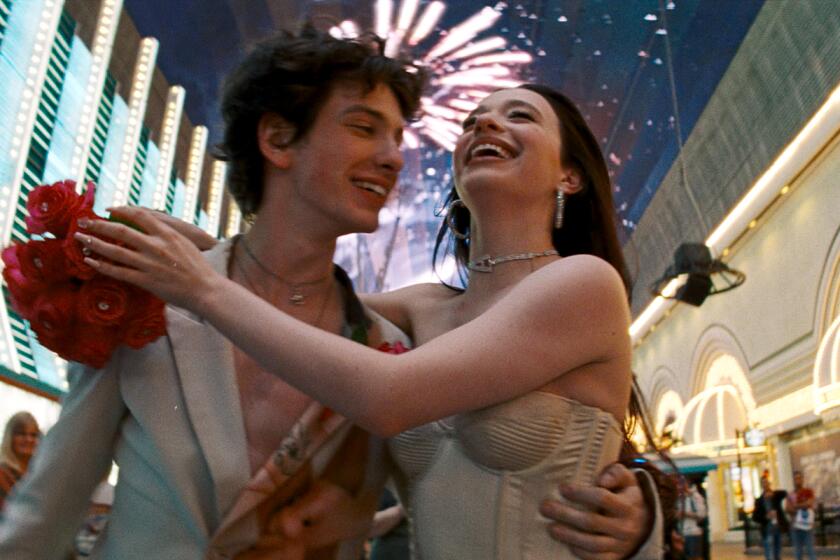Messages Loud and Clear
- Share via
Many of the exhibitions mounted in the Skylight Gallery of Glendale’s Brand Library take advantage of the venue’s wide open space and gentle dispersal of light. By virtue of the gallery ambience, the art here can be meditative even when the edges are rough.
It’s a different story with the large, loud paintings of the artist known simply as Klever. These paintings, with their dense, gnarly visions of humanity in crisis, make the space seem suddenly claustrophobic, choked with shades of red that seem to convey passion, dread and communist terror all at once. But that’s the point.
Although the pieces were created in a style loaded with surrealism and symbolism, the underlying messages about life under communist rule are loud and clear. This is art about a state of siege and censorship, by an artist who knew of these realities firsthand.
An emigre who left the former Soviet Union in 1978, Klever produced this body of work in the late ‘60s and ‘70s in Leningrad and was arrested several times for his art. The offending paintings themselves were hidden in the U.S.S.R. for years, then smuggled to Paris, where they have been stored until recently. This is the first exhibition of the paintings in the United States. The artist’s story adds to the intrigue of the show, beyond issues of artistic skill or subtlety, which is sometimes lacking.
The work has some of the markings of political art, with its recurring motifs and faces we associate with the oppressive legacy of the Soviet Union. Everywhere we turn, there are telltale signs--Lenin’s mug; the pervasive, invasive eye of the KGB; and things red, including red flags flying from the spires of churches, indicating the imposition of the state on the church, along with other facets of Soviet life.
Klever’s personal struggles are referred to as well in such self-portraits as “Guitar-Playing Soldier” from 1967, in which the artist, who spent time as a soldier, is harassed by his superiors, his music squelched. “Snakes of the U.S.S.R.” is a Cubist-like image, dealing with fork-tongued citizens whose betrayal leads the KGB to arrest an artist neighbor who expresses anti-state ideas on canvas.
At the same time that he deals more or less directly with Soviet life, the artist shows the gift for poetic abstraction and subterfuge endemic to artists working under repressive conditions, a specialty of artists behind the Iron Curtain. Humanity is rarely presented head-on, in a realistic way, but is reduced to puppets and mannequins, or seen as limbs and body parts in disarray. Faces are usually obscured or covered in bandages--except those omnipresent faces of Soviet leaders, of course.
With “Trio,” Klever creates a Max Beckmann-like allegory, in which a soldier holds huge fish, with peasants trodden underfoot. “Mother Russia and Her Heroes” finds the cultural mother’s body tied up and speckled with the badge-like faces of power-mad despots and leaders. Klever takes refuge in the realms of the symbolic and the theatrical, but never at the expense of visceral intensity.
If these paintings sometimes appear clumsy or crude in their execution, the message is nonetheless potent. Here is the work of an artist who had precious little of the creative freedom we enjoy in the West and who channeled his frustrations and sense of foreboding into creative means. At the same time, life under the hammer and sickle gave him a powerful subject to draw upon.
*
FACE-OFF: Anju Badhwar, an artist trained in India, presents a very different mode of art in the Brand’s Atrium Gallery, in which portraiture is manipulated in various ways to reveal an aesthetic more about internal exploration than faces. She’s an artist on a spiritual quest, with no simple answers or pat artistic agenda.
Faces are often half-hidden or unfinished, integrated into dark, muted backdrops. Mysterious as they appear, the paintings harness a bold visual effect, especially in works such as “Edge of the Sword,” “Tribal Lord” and “Oceanic Experience.” In “The Last Prayer,” a woman’s face appears like a cracked mask on a black ground, as if peeling away identity.
“On the Cross” consists of four purple-hued pieces, alluding to the essence of women, serpents and the ubiquitous cruciform design in Christianity. These biblical elements are questioned as much as they are meditated upon, a basic attitude of duality that gives Badhwar’s art its prevailing theme.
* Klever and Anju Badhwar, through May 30 at the Brand Library, 1601 W. Mountain St., Glendale. Gallery hours: Tuesday and Thursday, 1-9 p.m., Wednesday, 1-6 p.m., Friday and Saturday, 1-5 p.m.; (818) 548-2051.
*
GALLERY UPDATE: The Clark Cierlak Fine Arts Gallery has set up shop in Sherman Oaks, at 14452 Ventura Boulevard, with the intention of both showcasing emerging artists and representing collectible works from the artworld at large. In other words: Cierlak wants to make the Valley safer for fine art.
This Sunday, starting at 11:30 a.m., there will be an auction of works, including pieces by Warhol, Lichtenstein, Jasper Johns and Sam Francis. The work is available to preview on Friday and Saturday, 10 a.m. to 5 p.m.
More to Read
The biggest entertainment stories
Get our big stories about Hollywood, film, television, music, arts, culture and more right in your inbox as soon as they publish.
You may occasionally receive promotional content from the Los Angeles Times.










